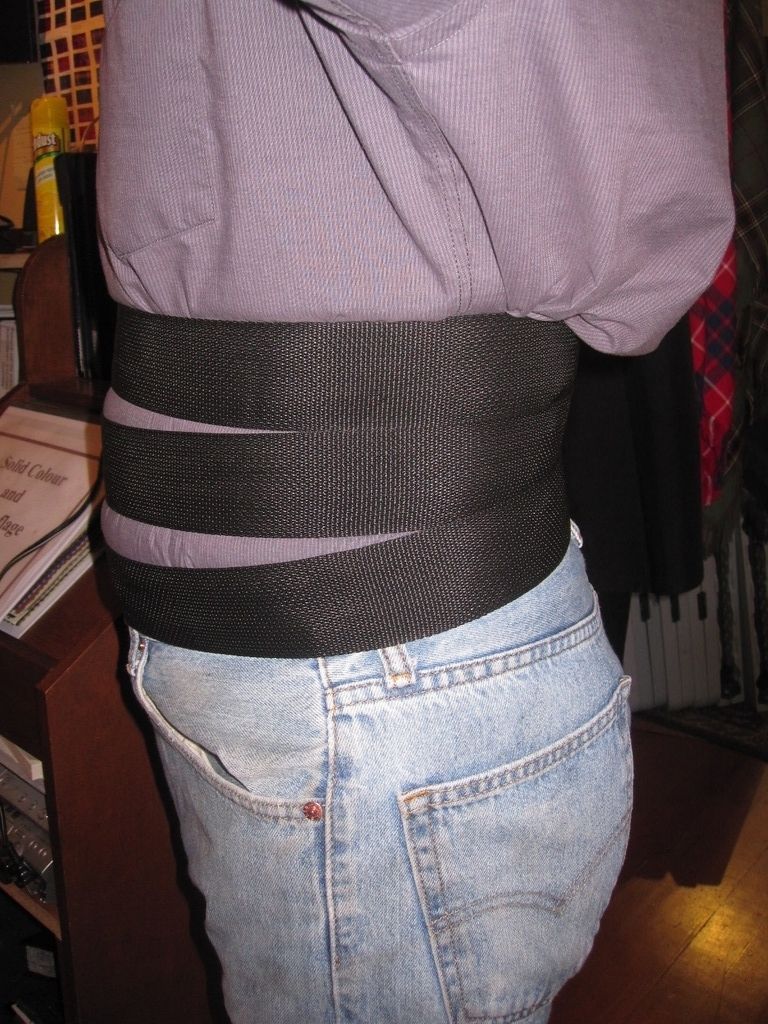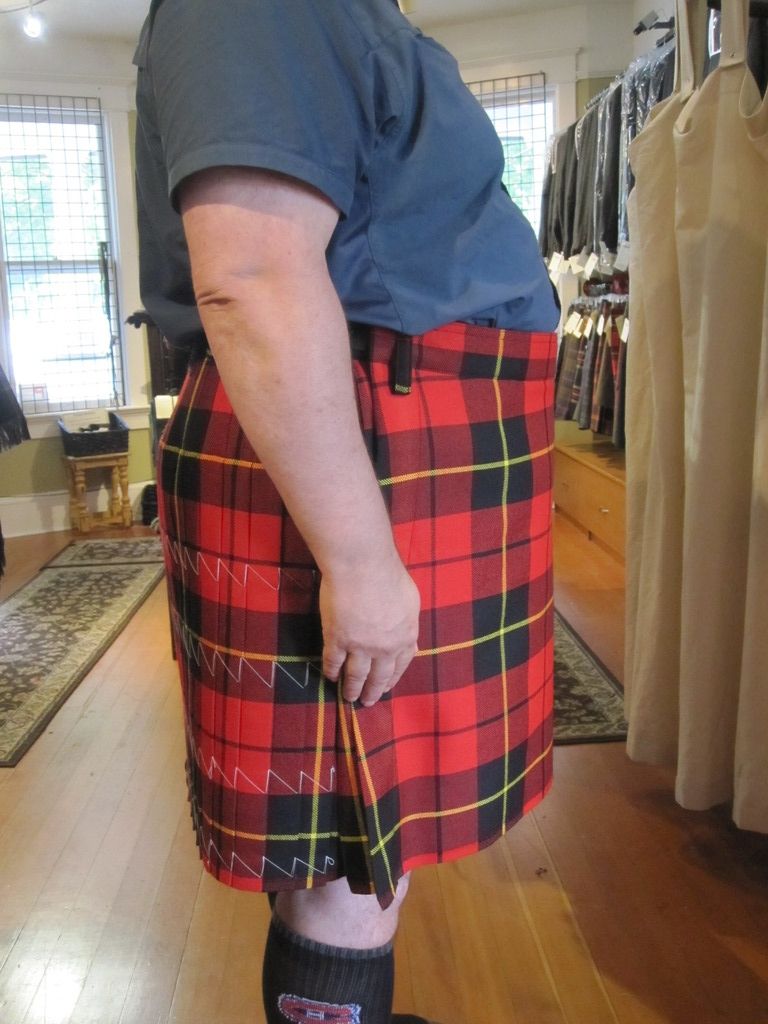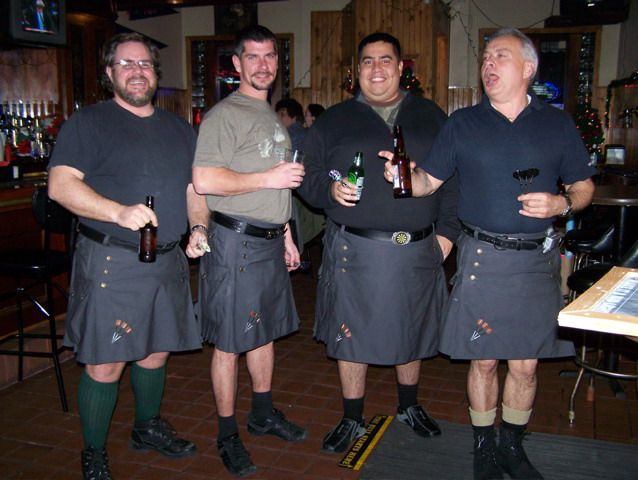|
-
11th November 16, 02:44 PM
#1
Uneven lower kilt hem
Hi, I am writing to see if anyone else has ever had to do this type of alteration. My husband wears kilts, but can never buy one that hangs "right" as purchased. If he orders one that has the correct "fall" to end up showing his knees in the front, the kilt is way too short in the back. So he buys kilts that are too long in the front, and I end up taking maybe 4 inches off the apron, and then tapering that 4" down until, somewhere around the third pleat past the buckle, it is back to the full length as originally made.
This is not an easy sewing project for me since I don't actually know much except how to make the machine go! Altering these kilts requires opening the hem, unpleating, laying out the new length (along that taper), sewing, and repleating. The finished item will then, when worn, measure about the same from the hem to the floor in both front and back. So the process does what I'm aiming for, but it's awkward; also of course if you look carefully from the side you can tell something's weird because the plaid pattern isn't parallel to the hem during the taper.
Anyway I would love to know if anyone else has ever needed to do anything like this, and if anyone has suggestions on a good procedure for doing it. Thanks.
-
-
11th November 16, 03:51 PM
#2
This problem of a hem that is lower in the front has plagued kilt wearers for a few years now.
It all stems from the idea that the kilt is not worn like pants. The top straps of all traditionally designed kilt is supposed to cinch into the natural or anatomical waist.
This is actually quite high on the body. Right up under the ribs.
All traditional kilts will also have more fabric above the top straps. This is called the 'rise'. The rise of the kilt goes up, over the ribs.
So a kilt made traditionally will fit well only when worn this way. The top edge of the kilt at the front will sit three or four finger widths below the bottom of the sternum or breastbone.
The problem comes in when today's guys, who have never worn anything up this high, try to wear a kilt lower like trousers.
The bottom of the 'Fell' (the part in the back that is tapered and sewn down) will drop below the crest of the hips and butt. This will often cause shower curtain folds in the back of the kilt.
But most noticeable will be that the front of the kilt wants to move down, lower than in the back. This causes large puckering of the front apron and the hem is now lower in the front than in the back.
Here is an illustration of what I am talking about.
The top black strap is at Full Rise. The center strap is at Mid Rise. The lower strap is at Low Rise.
At Full Rise the top of the kilt is horizontal.

You can see in this picture taken from the side that as the kilt is worn lower the front begins to drop down further than the back.

If a guy wants to wear his kilt lower than it was designed to be worn a few things must be done. But they are done from the top down not from the hem up.
The first thing you need to check is if the kilt is the correct length. I don't mean total length. I mean from the very top of the kilt down to the bottom of the Fell.
You look at the back. The bottom of where the pleats are sewn down should be at the bottom of the crest of the hips and butt.
You can find the point easily. It happens to be just about the same place as the hip joint.
Have the person put the kilt on and adjust the waist up and down until the bottom of the Fell is at the crest of the hips.
Have the person lift one leg. Find the hip joint with your hand and see if the bottom of the Fell is no lower than this point.
It can be an inch higher but no lower.
If the hem is now at the top of the knee cap the kilt is the correct length.
Then get some sort belt or strap. without moving or adjusting the kilt put the strap around the kilt where the person wishes to wear the waistband. You don't look at the top edge of the kilt. for this you are looking at where the top straps are.
Mark the kilt with chalk at the top of the strap.
Now lay the kilt out on a table. (You will notice that the kilt will not lay flat. If you make the Fell lay flat the pleats will splay out. If you want to make the pleats lay flat and parallell you have to lift the Fell up.)
This is where you would have to cut the kllt to make it fit the new waist position.
Last edited by The Wizard of BC; 11th November 16 at 04:04 PM.
Steve Ashton
www.freedomkilts.com
Skype (webcam enabled) thewizardofbc
I wear the kilt because: Swish + Swagger = Swoon.
-
The Following 4 Users say 'Aye' to The Wizard of BC For This Useful Post:
-
11th November 16, 04:05 PM
#3
Thanks, that is very, very interesting!
I just have a couple barriers to this working for me: first of all, my husband is very "portly", so what you say about wearing the kilt high has only limited application! He does not wear it like pants, but he can't wear it up by shirt-pocket height (as in your photo), because that would put it above the, er, thick part, and he'd look like he had a maternity dress on, unfortunately.
Second problem for me is that, as I mentioned, my sewing skills are very rudimentary; shortening these hems is challenging for me, but rebuilding a full pleated-and-sewn waistband would I think be way beyond me.
Is there any help for us even if I can't quite follow that advice?
-
-
11th November 16, 07:18 PM
#4
-
The Following 3 Users say 'Aye' to The Wizard of BC For This Useful Post:
-
11th November 16, 07:46 PM
#5
Being a portly fellow
I can tell you personally that what Steve is telling you is absolutely so. I am a portly fellow and I tell you honestly a kilt is much more comfortable to wear and looks so much better when the top of the front apron of the kilt is worn at or a bit above the belly button I also use sporran straps instead of sporran belt and chains because the chains tend to make the sporran hang to low and accentuate the tummy.You might think wearing the kilt like this will take a while to get use to but it doesn't because the kilt is so much more comfortable......... I also have suspender buttons sewed onto my kilt and wear suspenders to stop the kilt from sliding down and with a waist coat on you would never know they are there. The kilt doesn't have to be cinched too tight or if wearing a belt it doesn't need to be cinched so tight it distorts the fall of the outer kilt apron.......mind you I wear suspenders all the time so am very comfortable with wearing them.......just my opinion though
Last edited by Terry Searl; 11th November 16 at 07:56 PM.
-
The Following User Says 'Aye' to Terry Searl For This Useful Post:
-
14th November 16, 04:44 AM
#6
Very helpful pictures, thanks. My husband does indeed wear his kilts well above the belly button, but that still constitutes mid rise by your photos; going to full rise would put the kilt waist like the 'old man pants' scenario you so accurately describe! Which scenario would cause the apron to stick out over the protrusion below, and then hang straight down from that point. Looking, like I said, like a maternity dress. So for him, the waist does have to be worn at mid rise not full rise.
I guess what I'm working with is closest to your side-view photo of the red-kilted fellow (the Habs fan!) getting fitted. And I see that you too have the issue I mentioned, about the lines of the plaid pattern no longer being parallel to the floor: in my ugly method, this happens at the hem, but even in your most correct method, it is somewhat visible at the waistband. So you know what I mean.
I now see that your way is the right way to make this modification; but unfortunately, I certainly do not have the skill to do it that way. Cutting down the waistband would involve dismantling and changing the interfacing, and worse for me, it would also involve redoing the buckles and strap locations. I never took a sewing class in my life -- I'm not up to attempting that!
Thanks very much for the information. At least I have learned that I was indeed aiming for the right end result. And since where we are, my husband might just be the only kilt-wearer to be seen, I'll just have to tell myself that no observer will be as knowledgeable as the Wizard of BC to pick out my errors. It's kind of a choice of doing what I can vs the man not wearing kilts at all....and everybody should be allowed to wear a kilt if they want, right?
Thanks again everyone.
Last edited by Dragon's Breath; 14th November 16 at 12:39 PM.
-
-
14th November 16, 11:43 AM
#7
If you would kindly tell us who is the maker of the kilts your husband has, there may be alternatives that could be done with your level of sewing experience.
Steve Ashton
www.freedomkilts.com
Skype (webcam enabled) thewizardofbc
I wear the kilt because: Swish + Swagger = Swoon.
-
-
14th November 16, 12:51 PM
#8
I am a little shy to say, but the kilts are just the more economy-grade ones. Damn' Near, UT Kilt, and Sport Kilt. Some cotton, some polyviscose, one wool. (A true traditional kilt is on the wish list for future, but not at this time.) I doubt there's much to suggest for me at my price point, but thanks so much for being so helpful. Those photos you posted were vastly informative to me!
-
-
14th November 16, 02:45 PM
#9
Just so we are using the same terms. Polyviscose is a term that has seen a lot of misuse. The first part "Poly" refers to Polyester. The second, "Viscose" is the British term for Rayon. So Polyviscose would mean a fabric woven from a blend of Polyester and Rayon fibers.
The term Polyviscose or P/V for short has been use by some makers incorrectly for almost any synthetic fibers. Perhaps the most misuse has been by the makers from Pakistan. They seem to have attached P/V to fabrics woven from Polyester and Cotton, Polyester and Acrylic, and even 100% Acrylic fabrics.
As the term would apply to a very specific blend of Polyester/Rayon, true P/V fabrics are actually not that common. The only reason I am pointing this out is because the cost of enough fabric to make an 8 yard kilt will usually be more than the total selling price of some of the kilts offered by the names you mention.
OH, and it is perfectly acceptable to name manufacturers here. Accurate information is what we are all after.
As most of the names you mention do not have the internal structural elements of stabilizer and interfacings, they are very simple to alter.
In some cases with some of the names you mention it is only a matter of removing to top waistband or narrow waistbanding - cutting the top of the kilt to the required shape - and restitching the waistband or waistbanding back on.
On most of the kilts from the names you give if there is some sort of what looks like lining inside the kilt, that lining is only there for show. Because traditional kilts have a lining. If you unstitch these false linings you find that there is nothing behind them.
The lining of a traditional kilt is there only to cover all the internal construction. The pleats are cut away if the back of the kilt needs to be made thinner so you don't sweat too much. The stabilizer is added to resist the stress of strapping the kilt on, so those stresses are not transferred to the stitching or to the fabric itself. Interfacing is added to give vertical stiffening to the garment in much the same way boning is used in corsets.
If these elements are not used, there is no need for the lining. But some makers do put a lining in. It is done just for show as it does not actually cover anything up.
Last edited by The Wizard of BC; 14th November 16 at 02:52 PM.
Steve Ashton
www.freedomkilts.com
Skype (webcam enabled) thewizardofbc
I wear the kilt because: Swish + Swagger = Swoon.
-
-
14th November 16, 02:58 PM
#10
And a further clarification. In my photos above the top red kilt is worn at full rise.
The dart team kilts are mid rise.
The lower kilt worn below the belly is a low rise kilt.
We don't look at where the kilt fits in the front. We look at where the straps fit in the back. The hem of the top kilt is actually horizontal and even to the floor. The bottom of the Fell where the pleats are no longer sewn down is also completely horizontal. Only the top waistband of the kilt is angled so that in the front the apron does not rise above the stomach. This is called "Slope".
Steve Ashton
www.freedomkilts.com
Skype (webcam enabled) thewizardofbc
I wear the kilt because: Swish + Swagger = Swoon.
-
The Following 2 Users say 'Aye' to The Wizard of BC For This Useful Post:
 Posting Permissions
Posting Permissions
- You may not post new threads
- You may not post replies
- You may not post attachments
- You may not edit your posts
-
Forum Rules
|
|




















Bookmarks